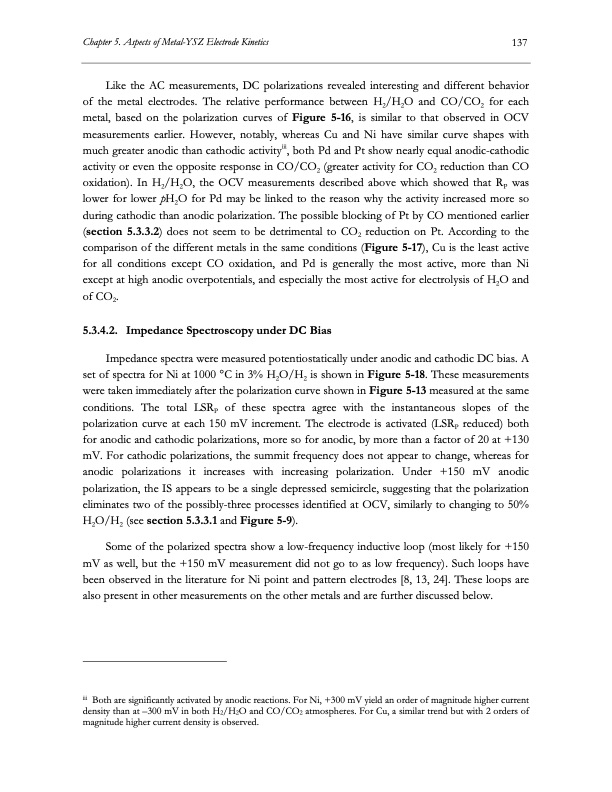
PDF Publication Title:
Text from PDF Page: 158
Chapter 5. Aspects of Metal-YSZ Electrode Kinetics 137 Like the AC measurements, DC polarizations revealed interesting and different behavior of the metal electrodes. The relative performance between H2/H2O and CO/CO2 for each metal, based on the polarization curves of Figure 5-16, is similar to that observed in OCV measurements earlier. However, notably, whereas Cu and Ni have similar curve shapes with much greater anodic than cathodic activityiii, both Pd and Pt show nearly equal anodic-cathodic activity or even the opposite response in CO/CO2 (greater activity for CO2 reduction than CO oxidation). In H2/H2O, the OCV measurements described above which showed that RP was lower for lower pH2O for Pd may be linked to the reason why the activity increased more so during cathodic than anodic polarization. The possible blocking of Pt by CO mentioned earlier (section 5.3.3.2) does not seem to be detrimental to CO2 reduction on Pt. According to the comparison of the different metals in the same conditions (Figure 5-17), Cu is the least active for all conditions except CO oxidation, and Pd is generally the most active, more than Ni except at high anodic overpotentials, and especially the most active for electrolysis of H2O and of CO2. 5.3.4.2. Impedance Spectroscopy under DC Bias Impedance spectra were measured potentiostatically under anodic and cathodic DC bias. A set of spectra for Ni at 1000 °C in 3% H2O/H2 is shown in Figure 5-18. These measurements were taken immediately after the polarization curve shown in Figure 5-13 measured at the same conditions. The total LSRP of these spectra agree with the instantaneous slopes of the polarization curve at each 150 mV increment. The electrode is activated (LSRP reduced) both for anodic and cathodic polarizations, more so for anodic, by more than a factor of 20 at +130 mV. For cathodic polarizations, the summit frequency does not appear to change, whereas for anodic polarizations it increases with increasing polarization. Under +150 mV anodic polarization, the IS appears to be a single depressed semicircle, suggesting that the polarization eliminates two of the possibly-three processes identified at OCV, similarly to changing to 50% H2O/H2 (see section 5.3.3.1 and Figure 5-9). Some of the polarized spectra show a low-frequency inductive loop (most likely for +150 mV as well, but the +150 mV measurement did not go to as low frequency). Such loops have been observed in the literature for Ni point and pattern electrodes [8, 13, 24]. These loops are also present in other measurements on the other metals and are further discussed below. iii Both are significantly activated by anodic reactions. For Ni, +300 mV yield an order of magnitude higher current density than at –300 mV in both H2/H2O and CO/CO2 atmospheres. For Cu, a similar trend but with 2 orders of magnitude higher current density is observed.PDF Image | Electrolysis of CO2 and H2O

PDF Search Title:
Electrolysis of CO2 and H2OOriginal File Name Searched:
co2-hso-fuels.pdfDIY PDF Search: Google It | Yahoo | Bing
NFT (Non Fungible Token): Buy our tech, design, development or system NFT and become part of our tech NFT network... More Info
IT XR Project Redstone NFT Available for Sale: NFT for high tech turbine design with one part 3D printed counter-rotating energy turbine. Be part of the future with this NFT. Can be bought and sold but only one design NFT exists. Royalties go to the developer (Infinity) to keep enhancing design and applications... More Info
Infinity Turbine IT XR Project Redstone Design: NFT for sale... NFT for high tech turbine design with one part 3D printed counter-rotating energy turbine. Includes all rights to this turbine design, including license for Fluid Handling Block I and II for the turbine assembly and housing. The NFT includes the blueprints (cad/cam), revenue streams, and all future development of the IT XR Project Redstone... More Info
Infinity Turbine ROT Radial Outflow Turbine 24 Design and Worldwide Rights: NFT for sale... NFT for the ROT 24 energy turbine. Be part of the future with this NFT. This design can be bought and sold but only one design NFT exists. You may manufacture the unit, or get the revenues from its sale from Infinity Turbine. Royalties go to the developer (Infinity) to keep enhancing design and applications... More Info
Infinity Supercritical CO2 10 Liter Extractor Design and Worldwide Rights: The Infinity Supercritical 10L CO2 extractor is for botanical oil extraction, which is rich in terpenes and can produce shelf ready full spectrum oil. With over 5 years of development, this industry leader mature extractor machine has been sold since 2015 and is part of many profitable businesses. The process can also be used for electrowinning, e-waste recycling, and lithium battery recycling, gold mining electronic wastes, precious metals. CO2 can also be used in a reverse fuel cell with nafion to make a gas-to-liquids fuel, such as methanol, ethanol and butanol or ethylene. Supercritical CO2 has also been used for treating nafion to make it more effective catalyst. This NFT is for the purchase of worldwide rights which includes the design. More Info
NFT (Non Fungible Token): Buy our tech, design, development or system NFT and become part of our tech NFT network... More Info
Infinity Turbine Products: Special for this month, any plans are $10,000 for complete Cad/Cam blueprints. License is for one build. Try before you buy a production license. May pay by Bitcoin or other Crypto. Products Page... More Info
| CONTACT TEL: 608-238-6001 Email: greg@infinityturbine.com | RSS | AMP |